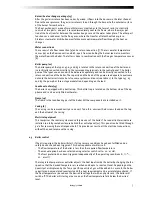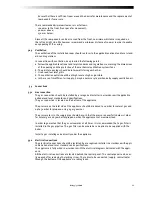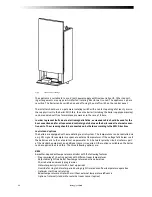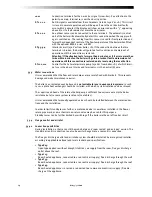
20
Doc653/30CV02A
5.4.2 Water pressure
5.4.2.1 Operating pressure
At a maximum fl ow temperature of 90°C and with the minimum water fl ow that occurs at a ∆t of
20K, the minimum operating pressure should be at least 1.5 bar. The operating pressure should be
measured when the pump is switched off. If a lower operating pressure is required, it is necessary
to adjust the maximum fl ow temperature.
Minimum operating
pressure in bar
Flow temperature in
°C
›1.5
90
›1
80
Table 12
Minimum operating pressures at a rated volume fl ow of Q
5.4.2.2 Boiler expansion vessel
It is recommended that a boiler expansion vessel is installed in the return pipe work between the
pump and the boiler shut off valves.
5.4.2.3 System expansion vessel
The size of the expansion vessel is determined by the water volume of the system. We recommend
that the system expansion tank is placed in the zero point of the low loss header.
5.4.2.4 Water pressure protection device
Install a pressure relief safety valve within 0.5 m of the appliance in the pipe between the appli-
ance and the shut-off valves if any, in accordance with BS6759. The size of this safety valve should
be at least
1
⁄
2
" but sized in accordance with the kW rating and system pressure.
5.4.3 Water temperature
The maximum permissible water fl ow temperature is 90°C. If the limit thermostat is triggered at
97°C, the boiler will switch off and will automatically restart when the water temperature falls be-
low the limit temperature that has been set. The high limit thermostat is set to 100°C, if activated
the boiler will switch off and will not automatically restart when the water temperature falls.
5.4.4 Water quality
x
The composition and quality of the system water has a direct effect on the performance of the
system as a whole, and the life of the boiler. Inappropriate addition and use of chemicals, water
softeners, oxygen components, de-aerators, aerators, and water fi lters increase the chance of
faults.
Corrosive elements in some additives may corrode the system, giving rise to leakages; undesir-
able deposits often damage the boiler heat exchangers.
In connection with the hardness of the water, a distinction should be made between the following:
a. Temporary hardness:
This is also termed carbonate hardness. Deposits are formed at higher temperature and can be
removed easily.
b. Permanent hardness:
Minerals (for example calcium sulphate) in the water that are deposited due to very high sur-
face temperatures.
The water hardness is generally expressed in terms of “ppm” and is sub-divided into the follow-
ing:
Summary of Contents for ECONOFLAME R30
Page 35: ...Doc653 30CV02A 31...
Page 36: ...32 Doc653 30CV02A...













































